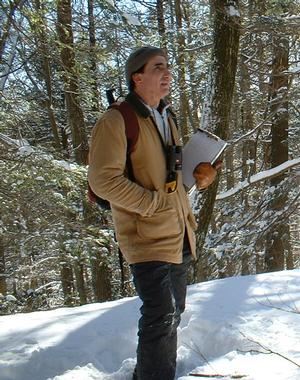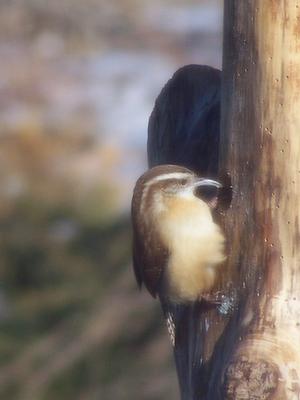
Dr. Robert Craig in the field

Carolina Wren on a woodpecker feeder log
Part I: Bird Conservation Research
Dr. Robert Craig, locally famous ornithologist, author and teacher has studied bird populations in all quarters of Connecticut and Rhode Island in every season. From steamy bug-infested swamps in summer to frozen ice-coated forests in winter this intrepid researcher has compiled fascinating documentation about the feathered creatures which inhabit the world beyond the windows of our homes. Birds, our feathered neighbors are squarely in the sites of our binoculars. We will examine some of his findings in this, Part I of An Exaltation of Larks.
Dr. Craig founded Bird Conservation Research (BCR) in 1999. This non-profit research foundation formulates scientific evaluation which provides municipalities, land trusts and others in making informed decisions regarding open space acquisitions and management. In this vein Robert has written texts which have been very helpful to towns interested in making careful choices in land set-asides. Among them are Forest Birds of the Last Green Valley and Discover the Critical Habitats of Connecticut. His most recent research will result in Forest Birds of Connecticut and Rhode Island, perhaps available by the airing of this series. Anyone interested in procuring these books can telephone (860) 928-2178 or visit the website at www.birdconservationresearch.org . Should you join BCR you will receive the electronic or paper newsletter which is informative and always interesting.
Dr. Craig states, “Southern New England conservation groups have identified the development of a high level, quantitative database on wildlife resources as key to developing substantive regional open space acquisition strategies”. In his eighth and final year of heavy-duty field work he continues to compile a comprehensive contemporary database of forest birds in southern New England. According to Robert birds are “by far the most diverse wildlife group of the region”. All of his compelling findings are being made available at no cost to town Conservation Commissions and other interested parties.
I asked Rob to share some lesser known facts regarding our regional woodlands and bird populations. He pointed out that forest communities are dynamic; woodlands metamorphose over long periods of time, transitioning through various successions until maturity is achieved. If undisturbed they change naturally: pioneer species of plants which draw certain species of birds and animals are replaced by successive communities, each with an associated bird-mammal-plant make-up. Regional climate patterns affect and development will stymie succession patterns which would naturally move towards a mature maple-beech-birch forest mix. But other events such as disease will determine which species might be more successful. West Nile virus sharply reduced crow numbers for several years. Wooly Adelgid on hemlocks killed enormous numbers of these magnificent conifers in Connecticut which in turn negatively impacted and reduced populations of conifer-associated bird species such as Blackburnian Warblers. Particularly cold, snowy winters will kill Carolina Wrens outright as they search in vain for enough food to sustain them through harsh times.
Robert indicated species doing well presently include Ovenbirds, Veery, Red-eyed Vireo and Scarlet Tanagers. I’m especially glad to hear about the Scarlet
Tanagers as I look for them every summer but only rarely catch a glimpse! On the other hand, birds associated with early succession forests are not fortunate. Farming is practiced less often in southern New England. We have moved into a time when our remaining forests are growing up, becoming denser, darker and graduating towards woodland mixes more closely associated with mature stands. This has severely affected the numbers of those birds that would be associated with early succession forests such as Least Flycatchers, both Yellow-billed and Black-billed Cuckoos and Whip-poor-wills. Sadly, they are seldom seen.
Another interesting point Robert made is that even on substantial land set-asides but those near larger cities, the number of species living in these preserves are many less than they would be if near smaller towns. Though it’s difficult to know with certainty several factors may contribute to the diminished number of species: feral cats and increased human foot traffic upset ground-nesting species. Skewed balances of plant species might directly dissuade species which might more heavily depend on those plants in fewer numbers. Also, soaring squirrel populations can tip the balance and impact species competing for the same foods.
A more hopeful piece of Dr. Craig’s research has demonstrated that many species congregate and winter in southern Connecticut. The warmer climate is the draw. There are conifer-loving species such as Pine Grosbeak, Red Crossbill and Redpoll that are more associated with the northern tier of counties but after fall migration can be found closer to the shore.
In Part II of An Exaltation of Larks we will take a more direct look at various feathered species which delight and enrich our lives. In the meantime please consider joining BCR. Your donation will be tax deductible. This is an important resource for all who love and live in the Last Green Valley. Stay tuned.